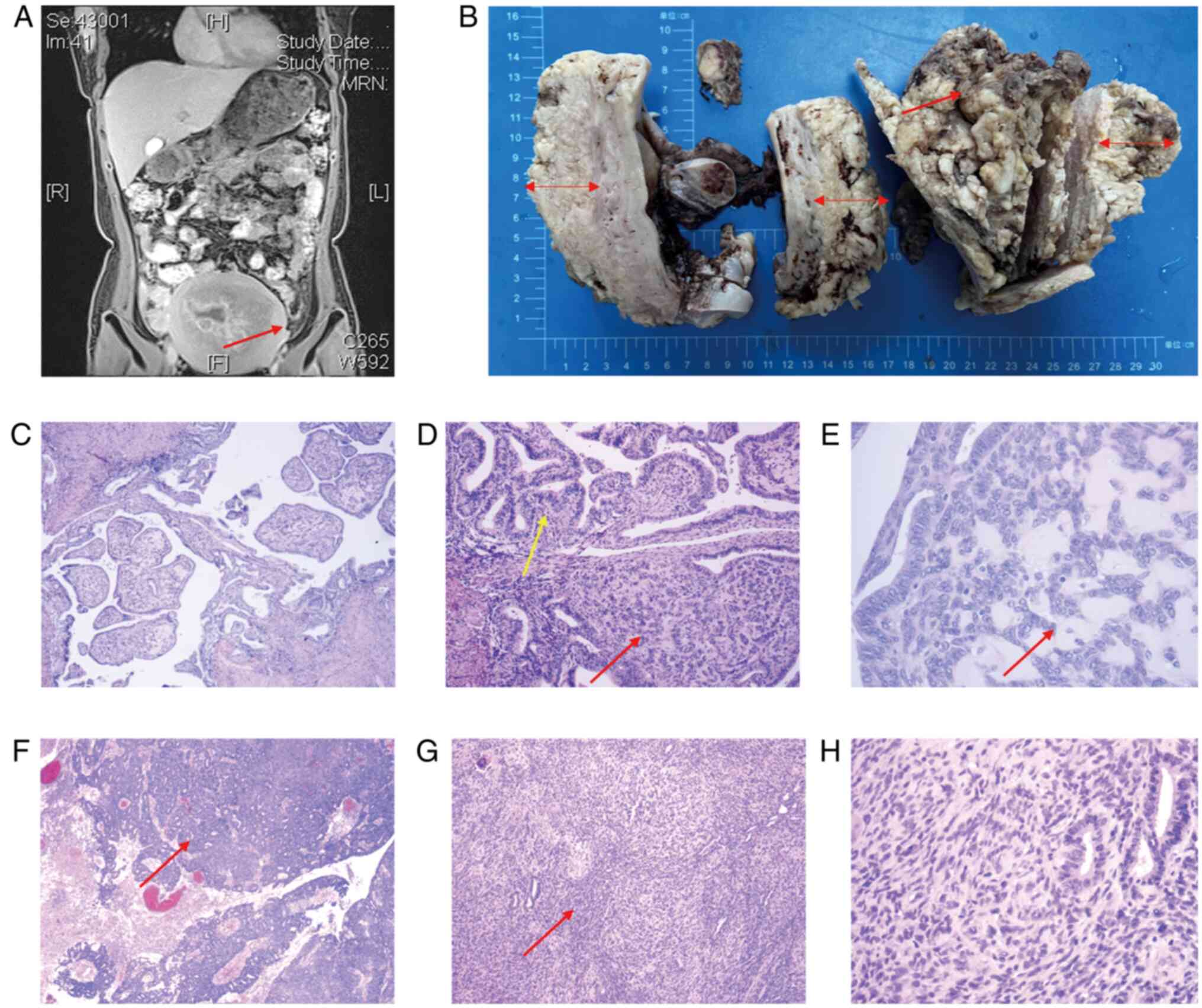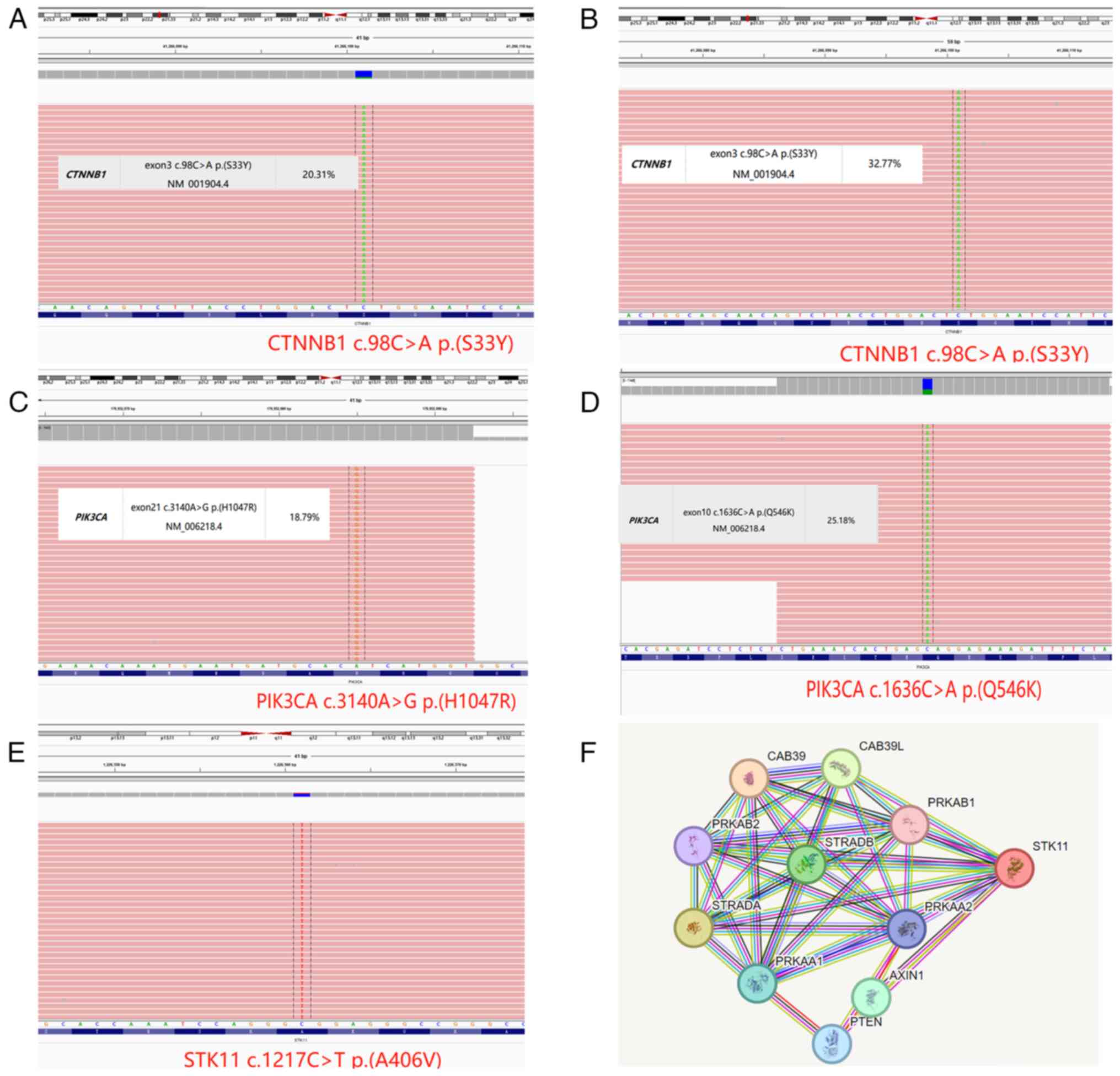|
1
|
Clement PB and Young RH: Endometrioid
carcinoma of the uterine corpus: A review of its pathology with
emphasis on recent advances and problematic aspects. Adv Anat
Pathol. 9:145–184. 2002. View Article : Google Scholar : PubMed/NCBI
|
|
2
|
Murray SK, Clement PB and Young RH:
Endometrioid carcinomas of the uterine corpus with sex cord-like
formations, hyalinization, and other unusual morphologic features:
A report of 31 cases of a neoplasm that may be confused with
carcinosarcoma and other uterine neoplasms. Am J Surg Pathol.
29:157–166. 2005. View Article : Google Scholar : PubMed/NCBI
|
|
3
|
Wani Y, Saegusa M and Notohara K: Aberrant
nuclear beta-catenin expression in the spindle or corded cells in
so-called corded and hyalinized endometrioid carcinomas. Another
critical role of the unique morphological feature. Histol
Histopathol. 24:149–155. 2009.PubMed/NCBI
|
|
4
|
Sun YH, Tang SX, Wang L, Yan YB and Zhou
XR: Endometrioid carcinoma with sex cord-like formations and
hyalinization of the uterine corpus: A clinicopathologic analysis
of 5 cases. Zhonghua Bing Li Xue Za Zhi. 45:297–301.
2016.PubMed/NCBI
|
|
5
|
Ladwig NR, Umetsu SE, Zaloudek C, Rabban J
and Garg K: Corded and hyalinized endometrioid adenocarcinoma
(CHEC) of the uterine corpus are characterized by CTNNB1 mutations
and can show adverse clinical outcomes. Int J Gynecol Pathol.
40:103–115. 2021. View Article : Google Scholar : PubMed/NCBI
|
|
6
|
Safdar NS, Thompson EF, Gilks CB, Isacson
C, Bennett JA, Clarke B, Young RH and Oliva E: Corded and
hyalinized and spindled endometrioid endometrial carcinoma: A
clinicopathologic and molecular analysis of 9 tumors based on the
TCGA classifier. Am J Surg Pathol. 45:1038–1046. 2021. View Article : Google Scholar : PubMed/NCBI
|
|
7
|
Travaglino A, Arciuolo D, Santoro A,
Raffone A, Pedone Anchora L, Piermattei A, Martinelli M, Mollo A,
Onori ME, Minucci A, et al: Corded and hyalinized endometrioid
endometrial carcinoma with high-grade features: A
clinicopathological and TCGA-based molecular analysis. Virchows
Arch. 482:671–678. 2023. View Article : Google Scholar : PubMed/NCBI
|
|
8
|
WHO Classification of Tumours Editorial
Board, . Female Genital Tumours. In: WHO Classiication of Tumours.
Volume 4. 5th. ARC Press; Lyon: 2020
|
|
9
|
Crosbie EJ, Kitson SJ, McAlpine JN,
Mukhopadhyay A, Powell ME and Singh N: Endometrial cancer. Lancet.
399:1412–1428. 2022. View Article : Google Scholar : PubMed/NCBI
|
|
10
|
Travaglino A, Arciuolo D, Santoro A,
Raffone A, Raimondo D, Casadio P, Seracchioli R, Fulgione C, Guida
M, Mollo A, et al: Corded and hyalinized endometrioid carcinoma:
Summary of clinical, histological, immunohistochemical and
molecular data. Pathol Res Pract. 247:1545152023. View Article : Google Scholar : PubMed/NCBI
|
|
11
|
Leskela S, Pérez-Mies B, Rosa-Rosa JM,
Cristobal E, Biscuola M, Palacios-Berraquero ML, Ong S, Matias-Guiu
Guia X and Palacios J: Molecular basis of tumor heterogeneity in
endometrial carcinosarcoma. Cancers (Basel). 11:9642019. View Article : Google Scholar : PubMed/NCBI
|
|
12
|
Contreras CM, Gurumurthy S, Haynie JM,
Shirley LJ, Akbay EA, Wingo SN, Schorge JO, Broaddus RR, Wong KK,
Bardeesy N and Castrillon DH: Loss of Lkb1 provokes highly invasive
endometrial adenocarcinomas. Cancer Res. 68:759–766. 2008.
View Article : Google Scholar : PubMed/NCBI
|
|
13
|
Xi Q, Kage H, Ogawa M, Matsunaga A,
Nishijima A, Sone K, Kawana K and Oda K: Genomic landscape of
endometrial, ovarian, and cervical cancers in Japan from the
database in the center for cancer genomics and advanced
therapeutics. Cancers (Basel). 16:1362023. View Article : Google Scholar : PubMed/NCBI
|
|
14
|
Tanwar PS, Kaneko-Tarui T, Zhang L, Tanaka
Y, Crum CP and Teixeira JM: Stromal liver kinase B1 [STK11]
signaling loss induces oviductal adenomas and endometrial cancer by
activating mammalian target of rapamycin complex 1. PLoS Genet.
8:e10029062012. View Article : Google Scholar : PubMed/NCBI
|
|
15
|
Launonen V: Mutations in the human
LKB1/STK11 gene. Hum Mutat. 26:291–297. 2005. View Article : Google Scholar : PubMed/NCBI
|
|
16
|
León-Castillo A, de Boer SM, Powell ME,
Mileshkin LR, Mackay HJ, Leary A, Nijman HW, Singh N, Pollock PM,
Bessette P, et al: Molecular classification of the PORTEC-3 trial
for high-risk endometrial cancer: Impact on prognosis and benefit
from adjuvant therapy. J Clin Oncol. 38:3388–3397. 2020. View Article : Google Scholar : PubMed/NCBI
|
|
17
|
Berek JS, Matias-Guiu X, Creutzberg C,
Fotopoulou C, Gaffney D, Kehoe S, Lindemann K, Mutch D and Concin
N: FIGO staging of endometrial cancer: 2023. Int J Gynaecol Obstet.
162:383–394. 2023. View Article : Google Scholar : PubMed/NCBI
|
|
18
|
Sinicrope FA: Lynch syndrome-associated
colorectal cancer. N Engl J Med. 379:764–773. 2018. View Article : Google Scholar : PubMed/NCBI
|
|
19
|
Nebot-Bral L, Coutzac C, Kannouche PL and
Chaput N: Why is immunotherapy effective (or not) in patients with
MSI/MMRD tumors? Bull Cancer. 106:105–113. 2019. View Article : Google Scholar : PubMed/NCBI
|
|
20
|
Concin N, Creutzberg CL, Vergote I, Cibula
D, Mirza MR, Marnitz S, Ledermann JA, Bosse T, Chargari C, Fagotti
A, et al: ESGO/ESTRO/ESP guidelines for the management of patients
with endometrial carcinoma. Virchows Arch. 478:153–190. 2021.
View Article : Google Scholar : PubMed/NCBI
|
|
21
|
Zyla RE, Hahn E and Hodgson A: Gene of the
month: STK11. J Clin Pathol. 74:681–685. 2021. View Article : Google Scholar : PubMed/NCBI
|
|
22
|
Dzung A, Saltari A, Tiso N, Lyck R, Dummer
R and Levesque MP: STK11 prevents invasion through signal
transducer and activator of transcription 3/5 and FAK repression in
cutaneous melanoma. J Invest Dermatol. 142:1171–1182.e1110. 2022.
View Article : Google Scholar : PubMed/NCBI
|
|
23
|
Azin M and Demehri S: STK11 loss: A novel
mechanism for melanoma metastasis with therapeutic implications. J
Invest Dermatol. 142:1007–1009. 2022. View Article : Google Scholar : PubMed/NCBI
|
|
24
|
Altamish M, Dahiya R, Singh AK, Mishra A,
Aljabali AAA, Satija S, Mehta M, Dureja H, Prasher P, Negi P, et
al: Role of the serine/threonine kinase 11 (STK11) or liver kinase
B1 (LKB1) gene in Peutz-Jeghers syndrome. Crit Rev Eukaryot Gene
Expr. 30:245–252. 2020. View Article : Google Scholar : PubMed/NCBI
|
|
25
|
Daniell J, Plazzer JP, Perera A and Macrae
F: An exploration of genotype-phenotype link between Peutz-Jeghers
syndrome and STK11: A review. Fam Cancer. 17:421–427. 2018.
View Article : Google Scholar : PubMed/NCBI
|
|
26
|
Bennett JA and Oliva E: The complex and
often confusing history, histology and histogenesis of mesonephric,
STK11 adnexal tumour and mesonephric-like neoplasms of the upper
female genital tract (including broad ligament). Histopathology.
81:280–296. 2022. View Article : Google Scholar : PubMed/NCBI
|
|
27
|
Chung SJ, Nagaraju GP, Nagalingam A,
Muniraj N, Kuppusamy P, Walker A, Woo J, Győrffy B, Gabrielson E,
Saxena NK, et al: ADIPOQ/adiponectin induces cytotoxic autophagy in
breast cancer cells through STK11/LKB1-mediated activation of the
AMPK-ULK1 axis. Autophagy. 13:1386–1403. 2017. View Article : Google Scholar : PubMed/NCBI
|
|
28
|
Zeqiraj E, Filippi BM, Deak M, Alessi DR
and van Aalten DM: Structure of the LKB1-STRAD-MO25 complex reveals
an allosteric mechanism of kinase activation. Science.
326:1707–1711. 2009. View Article : Google Scholar : PubMed/NCBI
|
|
29
|
Zhang Y, Meng Q, Sun Q, Xu ZX, Zhou H and
Wang Y: LKB1 deficiency-induced metabolic reprogramming in
tumorigenesis and non-neoplastic diseases. Mol Metab.
44:1011312021. View Article : Google Scholar : PubMed/NCBI
|
|
30
|
Li W, Wong CC, Zhang X, Kang W, Nakatsu G,
Zhao Q, Chen H, Go MYY, Chiu PWY, Wang X, et al: CAB39L elicited an
anti-Warburg effect via a LKB1-AMPK-PGC1α axis to inhibit gastric
tumorigenesis. Oncogene. 37:6383–6398. 2018. View Article : Google Scholar : PubMed/NCBI
|
|
31
|
Jia C, Medina V, Liu C, He L, Qian D,
Taojian T, Okamoto CT and Stiles BL: Crosstalk of LKB1- and
PTEN-regulated signals in liver morphogenesis and tumor
development. Hepatol Commun. 1:153–167. 2017. View Article : Google Scholar : PubMed/NCBI
|
|
32
|
Yue Y, Zhang C, Zhao X, Liu S, Lv X, Zhang
S, Yang J, Chen L, Duan H, Zhang Y, et al: Tiam1 mediates Rac1
activation and contraction-induced glucose uptake in skeletal
muscle cells. FASEB J. 35:e212102021. View Article : Google Scholar : PubMed/NCBI
|
|
33
|
Ren G, Ding YW, Wang LL and Jiang JD:
Berberine stimulates lysosomal AMPK independent of PEN2 and
maintains cellular AMPK activity through inhibiting the
dephosphorylation regulator UHRF1. Front Pharmacol. 14:11486112023.
View Article : Google Scholar : PubMed/NCBI
|
|
34
|
Wang Z, Li K, Lu C, Feng M, Lin C, Yin G,
Luo D, Liu W, Jin K, Dou Y, et al: Metformin promotes anti-tumor
immunity in STK11 mutant NSCLC through AXIN1-dependent upregulation
of multiple nucleotide metabolites. Oncol Res. 32:1637–1648. 2024.
View Article : Google Scholar : PubMed/NCBI
|
|
35
|
Shackelford DB and Shaw RJ: The LKB1-AMPK
pathway: Metabolism and growth control in tumour suppression. Nat
Rev Cancer. 9:563–575. 2009. View
Article : Google Scholar : PubMed/NCBI
|
|
36
|
Deguchi A, Miyoshi H, Kojima Y, Okawa K,
Aoki M and Taketo MM: LKB1 suppresses p21-activated kinase-1 (PAK1)
by phosphorylation of Thr109 in the p21-binding domain. J Biol
Chem. 285:18283–18290. 2010. View Article : Google Scholar : PubMed/NCBI
|
|
37
|
Karimian A, Ahmadi Y and Yousefi B:
Multiple functions of p21 in cell cycle, apoptosis and
transcriptional regulation after DNA damage. DNA Repair (Amst).
42:63–71. 2016. View Article : Google Scholar : PubMed/NCBI
|
|
38
|
Baumgartner C, Yadav AK and Chefetz I:
AMPK-like proteins and their function in female reproduction and
gynecologic cancer. Adv Protein Chem Struct Biol. 134:245–270.
2023. View Article : Google Scholar : PubMed/NCBI
|

















